

This was a 2 hour surgery. Piece of cake (I was "out" for about 3 hours total). Last thing I remember was saying "goodnight" to the nurse in the OR. Waking up was awful. Double vision, felt like a really bad hangover. An hour later, it was gone, but I was still shaky. Mike and Deb got me home and into my recliner, where I stayed until the next morning. Slept amazingly well.
They gave me prescriptions for antibiotics (2500mg / day !!) and pain. Night of the surgery, I just took one tylenol. I had to take half doses of tylenol for 3 - 4 days. Pressure / pain was not bad, but was very annoying.


They put a plastic cup / protector on the ear and told me not to touch it for 5 days. It's feels like a tight headband on top of an earache. One of the written instructions says "Don't blow your nose for 3 weeks". I have no noticeable swelling anywhere, but my jaw and neck ache a little and I can't open my mouth all the way, my jaw hurts back near my ear when I do that. Minor stuff.
Lexie (my cat) is very nervous about my head gear.
After 2 days the head cup got to be irritating around the edges, but I was too concerned to take it off. Both the doctor and nurse told me to leave it alone for 5 days.
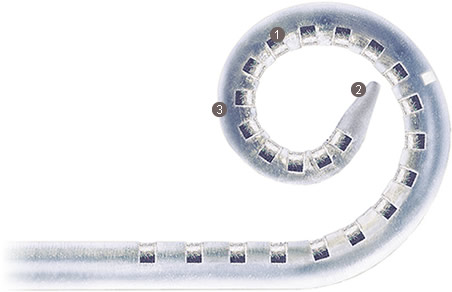 The doctor said he was able to insert the wire very far into my cochlear, which means there are more electrodes in there now. These are all along the wire and used to tune the sounds going into the nerve to your brain. The more electrodes that get into the cochlear, the finer they can tweak the nerve signal. This is very good news.
The doctor said he was able to insert the wire very far into my cochlear, which means there are more electrodes in there now. These are all along the wire and used to tune the sounds going into the nerve to your brain. The more electrodes that get into the cochlear, the finer they can tweak the nerve signal. This is very good news.
Each electrode is stimulated by the microphone and electronics that make up the implant package. The electrodes are somewhat similar to piano keys, ranging from low frequency bass notes to high frequency trebble notes. 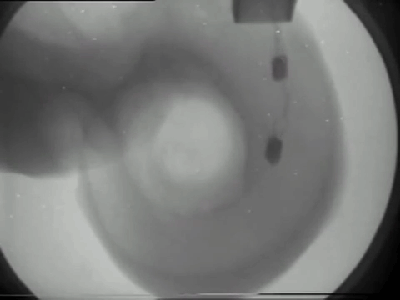 For example, if they can get 20 electrodes into your cochlear, they have 20 "piano keys" that can be tuned (by computer programs). Upon receiving the total sound input from the microphone & electronics each key will stimulate the nerve cells at a specific frequency. Your brain (hopefully) reconstructs the sound that went into the microphone, using the 20 little (digital) frequency packets sent to it by the elcectrodes. It's not a perfect replication of the real world analog sound, but if there are enough electrodes, it can be good enough for your brain to eventually learn how to interpret correctly. It is reported that this re-learning takes from 6 to 18 months, and has varying degrees of success, in terms of word recognition. (Almost everyone with implants, still needs to read lips.)
For example, if they can get 20 electrodes into your cochlear, they have 20 "piano keys" that can be tuned (by computer programs). Upon receiving the total sound input from the microphone & electronics each key will stimulate the nerve cells at a specific frequency. Your brain (hopefully) reconstructs the sound that went into the microphone, using the 20 little (digital) frequency packets sent to it by the elcectrodes. It's not a perfect replication of the real world analog sound, but if there are enough electrodes, it can be good enough for your brain to eventually learn how to interpret correctly. It is reported that this re-learning takes from 6 to 18 months, and has varying degrees of success, in terms of word recognition. (Almost everyone with implants, still needs to read lips.)
So, with this cochlear implant package example, your brain can now only recieve 20 specific frequencies. The ears of normal people recieve almost an infinity of frequencies, because normal ears are analog (continuous frequency spectrum) while cochlear implants are digital (a small number of chopped up frequencies).
Note: The auditory nerve does not atrophy.
This is the key to how deaf people can hear by using a cochlear implant.
Despite that the auditory nerve of a deaf person has not been used (or has been seriously under-used) for years (or decades), the nerve does not atrophy (wither away). It remains "ready to serve" whenever you give it a signal to send to the brain.
Is it better than being deaf - YES IT IS!
Is it as good a normal hearing - NO IT AIN'T !
3 Weeks post-op visit:Doctor said that he got all 22 electrodes into my cochlear, which is the best you can get (in today's technology). Looking forward to activating this thing (3 weeks from now).
My ear felt a little "tight", and the skin was wrinkled from being bandaged for 5 days, but things look pretty good to me. There was only a small amount of dried blood on the gauze pads they had applied. (I didn't know what I was going to find under that plastic cup.) The incision scar is well hidden by my ear.
There is a purple-ish bruise streak for about 6" down my neck, from the surgery. (After 7 days it started to fade away.) The purple mark on my ear is a marker the doctor put there to be sure the guys in the OR picked the correct ear !! I cannot wash it off. Hopefully it wil dissolve in time.
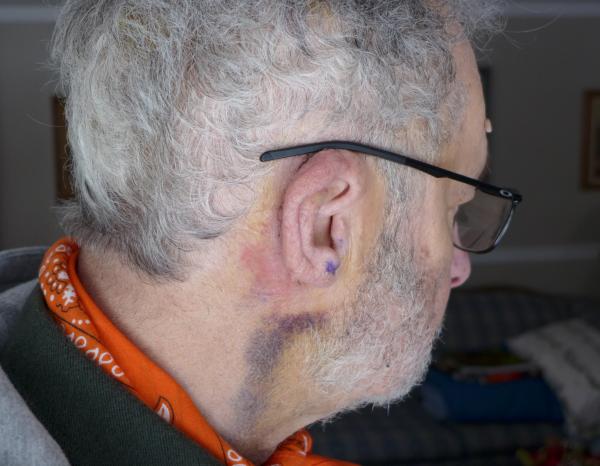
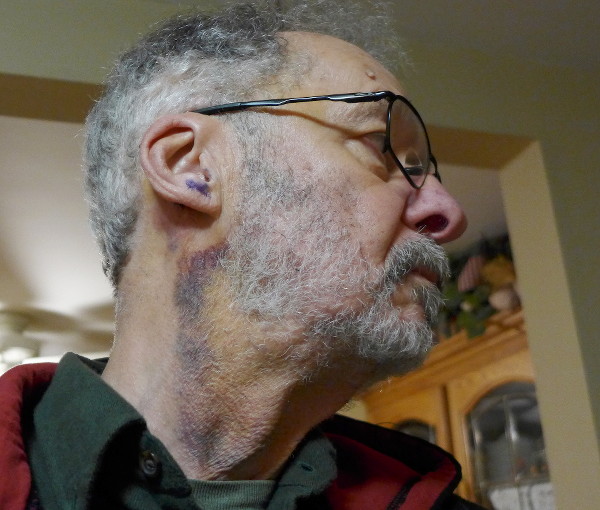
 The implant ear feels plugged all the time; like I have a head cold (I don't). I can temporarily unplug it by titling my head. Probably due to the coil moving inside my cochlear? Will this effect go away?
The implant ear feels plugged all the time; like I have a head cold (I don't). I can temporarily unplug it by titling my head. Probably due to the coil moving inside my cochlear? Will this effect go away?
I still use a hearing aid in my other ear, and hearing is a little strange now. I hear zero out of my right ear of course, so my "total" hearing is down (to half?). When I crank the left hearing aid up so I can hear better, it physially hurts BOTH ears and my head !! I expect this will work out after we turn the implant on and I can hear without cranking the left hearing aid so high. But until then (next month) we have to live with even lower hearing levels than before. (Poor Deb.)
The discomfort has decreased steadily since day #3.
I am sleeping with a knit cap to protect that ear. About 1000X more comfortable that that plastic cup they gave me.
Deb has been a wonderful "nurse" and Mike worries too much about me :)
Checkup showed all is good and well-healed. He saw some fluid behind my ear drum. That is not unusual, but until it goes away, that ear will get blocked up from time to time - meaning it will feel like I am under water or like I'm in a descending airplane. I have already felt that effect and it is really annoying.
We are not activating the implant for another 3 weeks, as planned. Don't know why they wait so long after the surgery.
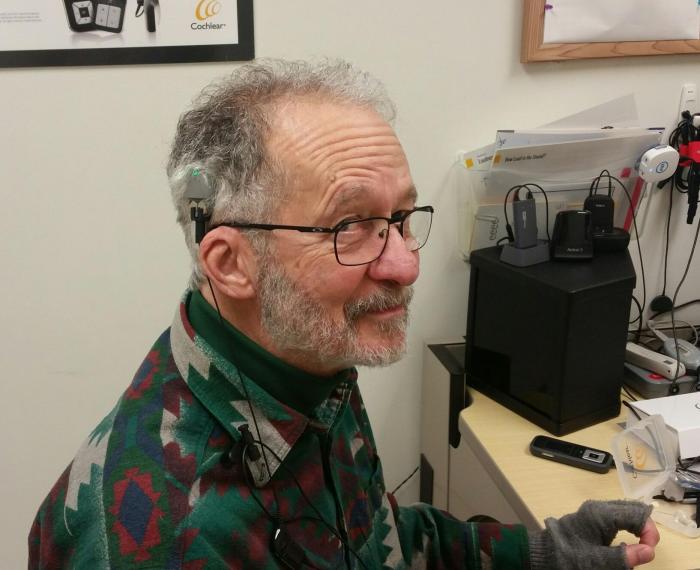
Yesterday was the big day.
I expected very little of this event, and to go home worried about the future. In fact, the appointment went just great, the experience was not disappointing and I went home very optimistic.
 For sure, what I hear is a buch of noise. Nothing like "normal hearing". I will try to describe this: all real sounds ("Hello Dave") are wrapped in weird other-worldy cyborg-like metallic noises, chirps and squeaks that are as loud as the real sounds. This is not "background noise"; it goes completely away when the real sound stops. It is noise added to the real sound. It is not "white noise" - like I said, it's squeaks, chirps, beeps, chimes ..... sounds like that. If I concentrate I can hear the real sounds, but it's not easy to pull it out from the noise. However .... (1) at least I can hear something (2) this is much better than I expected, and (3) they say with training and practice, I will get better at interpreting what it is I hear.
For sure, what I hear is a buch of noise. Nothing like "normal hearing". I will try to describe this: all real sounds ("Hello Dave") are wrapped in weird other-worldy cyborg-like metallic noises, chirps and squeaks that are as loud as the real sounds. This is not "background noise"; it goes completely away when the real sound stops. It is noise added to the real sound. It is not "white noise" - like I said, it's squeaks, chirps, beeps, chimes ..... sounds like that. If I concentrate I can hear the real sounds, but it's not easy to pull it out from the noise. However .... (1) at least I can hear something (2) this is much better than I expected, and (3) they say with training and practice, I will get better at interpreting what it is I hear.
The instructions were to leave the new device on and my other hearing aid 100% of every waking hour. The brain has to re-learn the signals being sent into it. They are now very different in character from the signals it has been getting for years, and also there are signals it hasn't received in half a lifetime. Also need to learn to live constantly impacted by sounds - now, it is NEVER quiet - that is really getting to me. No complete silence - there is always some kind of sound. It's kind of annoying, really.
It is strange, but I hear my voice better, and recognize the words better, when I whisper (!), rather than when I speak normally.
At this moment (early morning, day #2) I feel the device is too sensitive. I have the volume turned down to the very lowest level, and I hear EVERYTHING - my breathing, keyboard and mouse clicks, the fan in the next room, my slippers touching the floor, the floor squeeking, tissues sliding out of the box, the water faucet sounds like a train of chains banging together. And the "cyborg noises" that surround the real sounds are just as bad. It's actually very annoying, and I'll ask the Dr to dial it back next week.
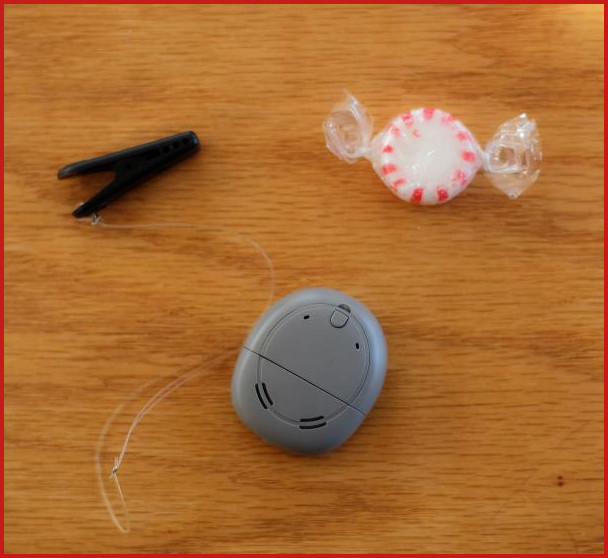
That gizmo above is the processor that sits outside my head and is held in place by a magnet that links to one inside my head (outside my skull, under my skin).
The safety clip goes to my shirt collar to catch the processor if it gets bumped off your head (which is not hard to do).
Footnote: There is nothing (like a connector of any kind) that sticks out of my head. The inside electronics and outside processor hold each other via magnets. People dont know this, and a few times when I reach up and take the processor off to show them, they cringe or jump because they think something is going to come out of my head or that there's a big hole in my head! There isn't!
The brain is an amazing thing (even old brains). Mine is getting very used to the sounds (signals) coming in from my audio nerves, even though the normal (with hearing aid) ear sends in signals very different from the cochlear implant ear.
I am taking off my "good ear" hearing aid for about an hour a day, to just hear only the sounds from the implant ear. Very different, very weird, but understandable if I concentrate. And together, both ears are doing really well. The normal ear sounds "natural" but it's missing the higher frequencies; the cochlear ear sounds very mechanical robotic, but accurately picks up the higher frequencies. The brain combines them, and it's kind of amazing how well it does.
I have to comment: I have "post linqual" deafness, which means that I knew words and the language very well before I went deaf. This is a big factor in how fast I am adjusting to recognizing words with an implant. I already know what to listen for, when people speak.
Word recognition is very good, but noise recognition ("what is making that noise?") is still really bad. I cannot tell what is making the noises I hear. The implant is very sensitive to picking up sounds (MUCH more than I had expected), but all noises still sound the same (chirps, squeaks, clangs, chimes, beeps). They say this will get better over time. I hope so.
Went to show off my implant to the wonderful audiologist who started me down this path, 2 or 3 years back. "Sometimes you have to take a 'leap of faith' to get where you need to go", she says. I agree. (Actually I think that Thomas Aquinas said that 500 years ago, but for 'blogging purposes, I will credit it to Dayna.)
Anyway, she is modifying both the mold and the wire of that hearing aid to fit into my ear better, and it should help with how my own voice sounds in that ear. We are definitely fine-tuning things at this point.
This is roughly what voices sound like through the implant processor. But (as noted above) there is also a "telegraph key" pinging sound over every vowel (not heard in this audio file) plus the squeaks, chirps and chimes that are the other room sounds:
What music sounds like through the implant is a real tragedy, and I don't see any future solution to this problem.
Listening to music with both ears (one hearing aid, one implant) through my basement stereo system, all I hear are the base notes (I mean the REALLY low thumpings) and everything else sounds like ukeleles. Ironically, I do have one CD where a uke is the lead instrument (with bass and drums behind it), and it sounds very much like it should. That one CD is enjoyable. But all other music sounds awful this way.
To listen to music, I remove my hearing aid and use ambient-sound-deadening headphones (just the one side of the headphones for that ear). That is still a pleasure, but of course it's monaural.
We did a soundbooth hearing test today. Listened to beeps of various frequencies and loudness, single words (male and female voices), complete sentences (with and without background noise). I scored 35% - 50% for the word tests; those are up from ZERO before the implant, and the doctor was happy with these results at only one month.
I don't feel the tests are a very accurate quantificaton of my actual experience. In reality (around the house), my word recognition is enormously improved from before the implant; my participation in normal room conversations is greatly improved. I would call it 1000X better than before; so I don't quite buy the low test scores. I explained this and we discussed why this may be so.
They tweaked the programs in my implant, and even gave me one designed for music. I haven't tried this out at home yet, and I don't have a lot of hope, but then again, we are only into this for one month now.
I am scrounging around on-line for hearing exercises, and for good computer speakers, but this may get into Pandora's box - is my little netbook sound card capable of driving good speakers to replicate high quality sound???
I went to the library and got a few audio book DVD's to play on my basement stereo system. One is playing now, and I hear it perfectly well, word for word. I expected to be struggling with this for weeks, as I expected it to sound horrible - like the tests we did yesterday. But in terms of word recognition it sounds just fine. I don't mean it sounds like normal hearing (it's still mechanical and robotic and noisy), but I understand virtually everything that is spoken on the DVD at a normal speech rate. (And I am not reading lips in this case!!) Keep in mind that the basement has no background noise, as you have in a restaurant or at a party. And again, around the house, having a one-on-one conversation is easy and about 1000X better than it was before.
I still cannot understand people who talk much faster than normal. Probably never will. It's partly my "old man" attitude - I say "slow down or shut up".
Making continuous but slower progress with hearing / interpreting through the implant. For normal conversation in a quiet room, it is just fabulous. Even in a car that I am driving, listening to the front passenger (my implant is on the right side). The electronics have some kind of a white noise reduction feature, that mutes wind and driving noises somewhat. This helps enormously. I don't have to turn to the passenger (to read lips) and she doesn't have to turn toward me.
This week I focused on my left (hearing aid) ear. The "other" audiologist made a new ear mold that fits better, and she boosted the amplitude of the lower frequencies (250Hz is the lowest the hearing aid can go). This had a very good effect on the combined sounds that I hear from both sides now. I haven't heard this well in 30 years !
Listening to the TV through it's own speakers is greatly improved from before these "fixes". Although it is still not great.
It's all kind of strange. I can hear the keyboard clicks of my wife texting on her cell phone two rooms away! But still do not understand every word spoken to me. I still read lips a bit and infer the words, based on the topic. (see below).
This is a fascinating topic that hearing people never think about.
Did I hear "blue" or "glue" ? .... well what your brain does without thinking about it is it decides what the word was based on what you were talking about. If you asked someone "What is your favorite color?" and you hear "_lue", your brain automatically fills in the "b" for you. This is how ventriloquists can talk without moving their lips, yet you think they are saying all the correct letters - they are not. They substitute "g" for "b" and "n" for "m", etc etc because (1) they wont have to move their lips and (2) your brain will fill in the correct letter, based on what it thinks the dummy is saying. The ventriloquist says "Klease nove gack" but your hear "Please move back" because that's what fits the conversation.
Deaf people have to do this very much more and much faster than hearing people, because we hear so many more garbled letters.
Is't knid of wierd hwo yuor brian wroks.
Very cool stuff.
There are two batteries in the processor, and it eats batteries at the rate of 2 batteries every 2 days. So, if I live another 10 years, the processor is going to use up 3650 batteries. They gave me two boxes of batteries, but they are going fast.
I was recently told that what eats up the batteries is the power needed to transmit the signal through my hair and skin. So .... next week I am shaving a small circular spot on my head to hopefully use less power. Not sure how much of a difference that will make, but it's worth a try. I must have thick skin because the holding magnet had to be the strongest one they make, so I have a battery drain problem because my skin & hair are too thick.
There are other designs with rechargeable batteries that sit in an additional unit behind your ear. I opted for this newest streamline design.
Trying to listen to a land-line phone recever is basically impossible on the implant side or hearing aid side. Removing the hearing aid can sometimes work if the person voice is clear and the line quality is good, but that's hit or miss.
Turning the land-line phone speaker on and holding it away from my head is do-able, but I can miss a lot of words and the conversation easily gets to be a problem, and I generally hate it. "Hi Mr. Leo"..... "Did you say Hi Mr. Leo?" .... "Yes" .... "Oh, Hi".
Cell phone is worse. Texting to my cell phone is the only possible option, and it's my favorite !
My talking-on-the-phone option is still the captioned phone that I have in the basement. Most people (on the other end) get used to it pretty quickly once I explain why there is this 6-7 second lag before I respond each time. Most people talk slower and clearer when I tell them, and I can sometimes understand them before the captioning is finished - by the way, the captioning makes mistakes, just like TV closed captions, and that really screws things up. Happily that's not too often.
This was the "3-month" exam. They did tests: (1) beeps, (2) single words with no background noise, (3) sentences with no background noise and (4) sentences with background noise.
My test results: (1) I didn't ask; (2) zero words understood; (3) all sentences understood; (4) zero sentences understood.
We talked a lot about this. I told them again that my every day conversational hearing is wonderful. In a quite room, I have no problems talking / listening to conversations. Noisy room are a lot harder (better than before, but still very hard for the noise.)
I told the audiologist the volume (loudness) of the impant was too loud. I keep it on the lowest possible loudness and wish it was lower. We talked and talked this over and over in light of today's test results. She ended up actually increasing the volume and making me promise to keep it at "level 6" and never go lower than "level 4". I reluctantly agreed. She also tweaked the 4 programs in the implant for lower frequencies, background noise and some other magical stuff, and gave me this card for my wallet. I promised to do as told, but I was (am) skeptical; she was (is) confident that it will help.
We talked about how my brain must continue to get used to (what I consider) "loud annoying sounds". She says "the world is a noisy place"; (but I am used to a very very quiet world). I talked about "signal to noise ratio" she talked about me doing what she tells me to do, so okay let's go her way I figure.
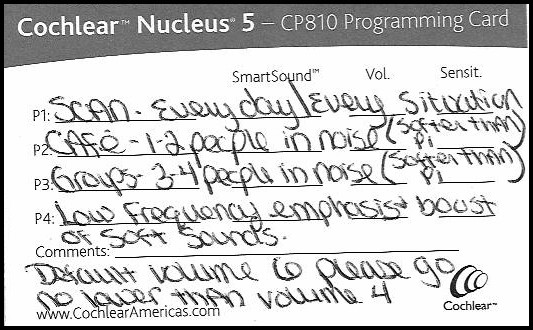
Today I have it set at "Scan / level 6". My voice sounds like God's voice in the CB Demille Bible movies.
My poor audiologist, Dr. Nicole S., has to put up with my relentless questions and me explaining to her ( ! ! ) all about sound and vibrations and how the implant designers have to correct their software to do this and that.
She bares all of that with patience and a smile.
So here is a big cheer for Dr. Nicole who is guiding me through the jungle of new noises that the world is feeding into my head.
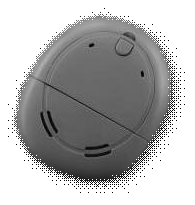 Sometimes It Pops Off My Head
Sometimes It Pops Off My HeadThe external sound processor is the button-like gizmo you see on the right. There is a magnet inside it that "sucks" onto a magnet that is inside the electronics under the skin. There is no connector that sticks out of my head; the external gizmo just pops off when you pull on it.
There are several strengths of magnets that can be used, depending on how thick your skin and underlying tissue is in your head. I have to use the 2nd strongest magnet availaible (I have a thick skull ??!!).
Several times, I have knocked the processor off my head by accident (scratching my head, using a hat, snagging the safety thread). Very smart to use the safety thread & clip attachment.
A few times, the processor has been sucked off my head by a metal car door frame and a window frame (porch storm window while I was pulling the screen up). It once got sucked off onto a metal post that I leaned against. This can be startling (you go instantly deaf again!), and if you're not careful and you move, it could pull the safety clip off your collar (this has not yet happened to me)
On the good side: the processor has fallen off my head onto a hard wood floor twice since I have it. No damage at all - still works fine.
I tried the TV bluetooth (TV-direct-to-implant) gizmo when I first got the implant. I felt it was useless at that point. Sounded like noisy garbage. This week decided to check it out again. I figured that I have since gotten used to the robotic mechanical implant sounds, so maybe I can use this thing. (This is 4 months after "turn-on".)
I was right - I find it much more useful now. I am not shy about turning up the volume (TV and implant processor) more than I did before, and I "understand" the voices better at this point, so much of the spoken dialog is clearer. I actually turn off the "annoying" closed captions now when I use it. Background music is still very annoying as I cannot "hear through it" to get to words being spoken. Background TV music is just useless annoying noise to me.
It took a few months of implant experience for me to warm up to the bluetooth TV gizmo. Now I use it whenever I watch TV or DVD movies. It works for streaming channels also, like Netflix, Amazon, etc.
Well, it's late August (implant was turned on in late February) and things are going very well for word recognition and normal conversation. No big changes, just getting slightly better and better, slowly, subconsciously. Identifying noises is still nearly impossible - everything sounds like slight variations of a bunch of chirps, clangs, squeeks so it's hard recognize what the sound is coming from. About 50% of the time I can identify the hiss of wind and blowing air (like a fan) and also electric motor whirring, and the cats' meows, floor squeeks and water out of a faucet. But that means that 50% of the time I cannot identify those sounds. I actually don't think that will ever get better.
Music is an ongoing tragedy. Music sounds like a band of ukuleles, banging sticks, whistles, tweets. Using a headphone on my other ear (hearing aid removed) sounds 100000X better than the implant ear. I don't think the necessary technology (for music through an implant) will get better in my lifetime.
The implant eats up two batteries every 2 days. This goes for both processors (they gave me a backup processor). According to Dr. S they should be lasting 4 days - but that is definitely not happening. I went through all the batteries she gave me back in February and bought another 3 boxes. I never got it clear about what the actual cost is because I have Medicare plus supplemental insurance so what I paid out of pocket coud be just a small part of the price. This bothers me enormously - I mean the ecological mess of trashing batteries every day like this for the rest on my life. But ..... I have no options, and I'm very glad to hear again.
My word and sentence recognition test scores, and my sound recognition, went up considerably, even though I don't notice any difference in everyday life. I still don't get the test data, but it doesn't matter to me because, in reality, I am very happy with this implant. I am now at the point that the perfect silence when I take it off makes me nervous, whereas I used to like the quiet.
The brain is an amazing thing. It is continually, automatically reprogramming itself to better understand the world around it. And it changes its own programming, as needed, when the input (like from your ears) changes.
I have tried several ways to attach a safety thread to the Cochlear processor, to catch it when it gets knocked off (which it does because I am not too careful). Today I came up with this. Today I took an old (and now useless) hearing aid, drilled a few holes in it - had to do some supergluing when I cracked it - and did what you see here.
It is working very well. I am sure the Cochlear design guys could make a more elegant version of this. In fact I'll probably have my hearing aid audiologist (that's my other ear) make a new casting of my ear so I can improve on this.
A burst of curiosity / inspiration hit me and I plugged my cell phone into my computer external speakers, and it is fabulous. Loud and clear !!! I highly recommend anyone who needs better cell phone hearing give this a try. I'd say, even if you don't have computer speakers, drop $30 and buy a pair to try this out - must be speakers that you power from a wall outlet.
I also have a captioned land-line phone and a bluetooth gizmo into my cochlear implant processor, and this speaker setup is much better than both of those.
Obviously this is only for at-home phone calls, but come to think of it, maybe a car setup would also work (?)
NOTE: you don't need a computer. Just get an inexpensive pair of speakers (BestBuy, Ebay, wherever). The computer is not involved in this. You can put the speakers anywhere in the house.
This setup is working very well. Plug the mini-mic into the cell phone and "bluetooth" the mic to the implants (using the remote control). There is also an accessory cellphone gadget that would do this without the wire. But, I always have the mini-mic with me (along with the cellphone, remote control, spare batteries, micro screw driver & battery pull magnet) and don't want to carry another gadget around. The sound quality is excellent.
This is a big deal if you are out on the road and need to use the cell phone.
I have the Cochlear Kanso sound processor, shown in various pictures above. There are a few accessories that allow you to wirelessly connect this processor to a cell phone and a TV, via Bluetooth. However, it will not connect to *any* Bluetooth enabled device. For example, I could not wirelessly connect my netbook to the Kanso processor, so if I wanted to hear music of whatever on my netbook, I needed to use its speakers, which is a pain when I'm not at my desk or somewhere like the library or the local cafe.
There is a workaround however.
The accessory microphone does wirelessly connect to the Kanso, *and* it (the microphone) has a wire input connector that can be plugged into any device with an output jack (like your computer). So, plug the microphone into the computer and you are wirelessly connected now, and can listen privately to your netbook anywhere (just remember to bring along the microphone and wire).
Don't leave the wire plugged into the microphone after you turn it off (after you stop listening via the mic): if the wire is plugged in when you turn the microphone on again, the mic will not go into the streaming mode. You must turn the microphone on first, then plug the wire in.
Using an adapter plug and cable, the mini-mic can also plug into your hi-fi amplifier/receiver or a portable CD player and Bluetooth music directly to your implant processors. So, you can listen to your favorite CD's and crank the Jazz up as loud as you desire!
NOTE: I get a distinctive hissing sound in the background when using the min-mic this way. Don't know what causes it. But .... see down below for other ways to Bluetooth electronics into your sound processors.
I have clipped the mini-mike to Deb's collar, when just we two are in a restaurant and also in a group of 6-8. It works very well in that one-on-one restaurant scenario, highlighting her voice over the noise.
But, in the group scenario, not so well, exactly because it highlights her voice and often drowns out the persons sitting next to me. I mean if she is across the table or the room, I hear her and her friends chatting better than I can hear the people next to me.
If I put the mike in the middle of the table or room, it's just the same as me sitting in the middle and it picks up everything equally loud, which is no good either because all I hear is a conglomeration of voices and noises.
But again, when it's only one person that I need to hear, it works very well.
A minor annoyance is the sound I get when something (like clothes or a hand) rubs against the microphone. Sounds like crushing tin foil in my ear. And if someone taps the mike, it hurts !
Like they say "your mileage may vary". but this is how much I personally need to spend on batteries. I eat up 2 batteries every 2 days. This is maybe only half the life that other people are experiencing, but I have a year's worth of experience and what I said is true for me.
I just got 180 batteries and the billing price is $108. That's 60¢ / battery = 60¢ / day at the rate I am using them up.
My insurance doesn't pick up any of that. So that's 0.6X365 = $219 / year.
The hospital that did my implant has started a support group. Went to my first meeting, and signed up for the next one in a few weeks. It was very enlightening to get other experiences with implants, and good to bond with others. It is wonderful being with people who understand what it's like to be deaf.
Next meeting is a technical guy who will explain implant design, frequencies, etc etc and take some questions. Being a retired engineer, I'll probably drive the poor guy crazy with questions. But I'll try to behave.
As I said way above here, the sounds out of the implant into my brain are very mechanical, cyborg-like. In terms of word recognition, once your brain gets accustomed to this, it's not a real problem, and you don't usually pay attention to this, your brain just goes with the flow.
In fact all sounds sound mechanical (see my comments above, right after I got the implant).
A peculiar, and kind of funny, result of this is that sometimes house noises (running water, floors squeeking, cats scratching) can sound like words. So it might sound like "######milk######shoe######glass#####" . Kind of funny & weird.
There were 10 people at the support group meeting last night, and it went well. A rep from the Cochlear Co. (my brand of implant - there are others) was there: Mark, deaf since birth, two implants. I had met him before I did my implant; that helped me decide to proceed.
I learned that I may be too lazy about the sound processing programs stored in my electronics; and I promise to try them out more, rather than just dealing with the one I use.
Also must revisit the Bluetooth microphone that's been sitting here unused. I had tried it out, didn't seem to help much, but one lady says it's great. Maybe I missed something.
I complained about the warning beep I get to tell me the implant battery was low. I get only 5 minutes from beep to dead battery. If I am out and about, this is bad. I just can't stop and change batteries quickly if I'm driving, in a store, etc.
The answer is: the batteries are designed to NOT drop voltage as time goes by - they output a constant voltage (to keep the electronics working and the output constant) until the very end of life. The voltage drops off very fast by design. Not a gradual slope (which would make your hearing drop off as the batteries wear on).
This makes sense to me, and it's logical.
Fast and the most accurated voice-to-screentext application that I have tried. Excellent when you need "closed captions" in conversations, meetings, movies, or whatever. (Cell phone needs to be connected to a wi-fi internet connection - or turn data transfer on - when in use.)
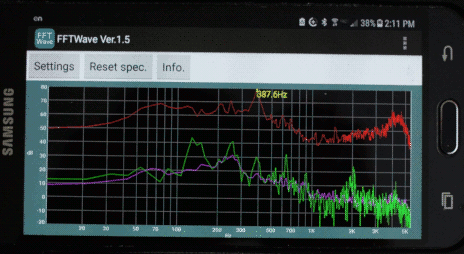
This very neat cell phone app (there are several) displays the noise spectrum of the room that you're in. I find it useful / educational for me to understand the background noise and how bad it is for my word recognition. I find that a background noise level of 70dB means that I won't understand half the words that are spoken around the table. At 80dB background noise, I may as well go home.
It also shows the fequencies of various sounds (spoken vowels or consonants, motors, fans, etc) to help me understand my own frequency hearing abilities (aside from sound room tests).
My implant sound processor (the gadget that sits outside my head) has 4 programs that tweak the incoming sound frequencies (from the outside world) before sending the signal into the electronics under my scalp. The programs let me pick the "kind of sound" that my brain favors for the environment I am in. Each program also has 10 volume output levels.
There is a complex noise-reducing feature added to each of the 4 programs. It is an attempt to let the processor sense any loud random "white" noise, and reduce the overall volume output of the processor frequencies. This happens automatically.
It's good in some situations and not good in others. For example, when listening to music (either through speakers or Bluetooth from the accessories - like the microphone) if the processor decides that it is "noise" it will drop the volume down very low. This happens for example when it hears cymbals or multiple instruments playing a chorus of many frequencies. This is bad. Also, when operating machinery, it cuts the sound volume. This may not be good if you have to hear how the machine is running.
Today I asked Dr. Nicole to remove this noise reduction feature from one of the 4 programs in my processor, so I can decide for myself when I want it on or off.
For the Record, here is how I spotted this behavior of the noise reduction feature. This is an e-mail I sent to Dr. Nicole and her reply.
Good morning, Nicole
I have a question about hearing specific frequencies (notes) through my implant processor.
I am experimenting with the new programs you set, and this week I'm going 100% with Program #1. It is very sensitive (I hear water flowing through our heating pipes!!!), but I'm leaving it set there for a week.
Here's my question: I have a frequency generator on my cell phone - it plays any single frequency that I choose and it holds the note steady. I am listening over computer speakers with and without my other hearing aid in and am listening through all 4 programs that you installed in my processor.
Whatever program I set at whatever loudness level, the single frequency (note), as heard through my implant, dies out after 5 seconds or so. I know the actual sound is still being played because I can hear it through my other hearing aid. But the implant lowers the sound to barely hearable. This happens at all frequencies.
Is this as-designed? At the moment, I don't like this effect, but maybe you can tell me why I should?
Hi Dave,
Great question. Any steady state sound such as the one you are playing, will eventually trigger the noise reduction feature in the sound processor as it identifies it as not speech. You want this feature active because for communication purposes it will help to filter out noise that you don't need to hear in order for you to hear and understand speech better. I have a few patients who have these features disabled, but I don't recommend it because then you have no filtering of background noises.
Nicole
Update (a few hours later): This will sound stupidly obvious, but I am just putting 2 and 2 together on this noise thing. I have always had a problem identifying noises. For example, flowing water and fan noise sound the same to me. But .... I just ran the faucet and switched between my noise-reduced program and the new no-noise-reduced program and the running water sounds much more identifiable as running water when I listen through the no-noise-reduction program. So, after having this new program for a few hours now, I am very optimistic that my noise identification ability will improve a good deal. I also expect that my music appreciation may increases quite a bit.
So . . . I would recommend that every new implant recipient have at least one program with no noise reduction.
Yep, I made up my mind. We did some testing of my other ear today, and I am seeing the surgeon in a week or so. Need to think seriously about which processor design I will go with. Probably do the surgery Sept or Oct. Kind of scary, but my other ear is pretty useless as it is for word recognition (however, see the next topic).
Surgery went very well. In the prep room they shot me with a tranquilizer and started to wheel me to the OR. On the way, things got more and more wonderful, and I kept saying "That stuff is wonderful". They put me on the operating table, I said it again, she said "Good night" and the last thing I saw was a mask coming down on me.
Next thing I knew, I was in post-op room trying to use the pee jar (not too successfully)
Deb and Mike got me home safely.
Wobbly wobbly for 4-6 hours. No pain at all (hospital pain killer still at work).
Had this urgent constant urge to pee, but never worked. This was *extremely* annoying and lasted 4-6 hours as well. Did not happen with the previous implant surgery.
Pain killer started wearing off in the evening, and I took one Tylenol at 9PM.
Prescriptions for anti-biotics (4/day) and prednizone (6/day), plus my metroprolol (2) and Eliquis(2) and probiotics(2), means I am taking 16 pills spread over 12 hours / day. (Note: Metoprolol and Eliquis are *not* related to this surgery.)

Slept okay on the sofa and chair with my head propped up. Actually slept well.
As last time, can't open my mouth very wide (jaw hurts), ear under the bandages itches a lot. Nose is runny but instructions say "Don't blow your nose for 4 weeks" !!
Changed bandages last night - not too scary, but did not get down to the stitches yet - nurse will do that today and clean it with peroxide.
Actually had a nurse friend come in and walk me through this. Glad that I asked her, I was nervous. Never did this for my first implant, but did not want to push my luck this time.
The peroxide did not burn at all. No pain whatever here. But the bandage was bloody (dry blood). Ear has a new weird shape, but that will stretch back over several months. Also, not as much numbness as the first implant.
Aching has gone down. I did not take any tylenol yesterday, so I guess that phase is over. (The hospital gave me a prescription for oxycodone, but I never had it filled.)
I have been a very little bit wobbly, moving around. You know the balance signals going into your brain's autopilot system come from your feet (the forces), your eyes and the fluid sloshing around in your ear canals. Obviously, ear surgery messes up the ear fluid, so your brain needs time to recalibrate its balance program. This could takes weeks or months, depending on the person and surgery. I had none of this after my first implant. It's not horrible, but I won't drive a car just yet and I'm careful moving around the house.
Healing up very well. No bleeding or oozing since we changed the first gauze pads days ago.
Skin is discolored from peroxide and topical anti-bacterial cream. Slight black & blu mark, not as bad as first implant surgery.
I no longer use the ear cup or bandages during the day in the house.
No aching (only took 2 Tylenol in the beginning).
Much less numbness than my first implant, but a little more balance-wobbly.
Meds are making food taste weird, but anti-biotics are done (I hate anti-biotics; am now taking pro-biotics to get back to normal).
Had to rig up a string thing to keep my glasses up off my new stitches. Annoying, but it worked.
Next week is surgeon post-op exam. The "big turn on" is in 3 weeks. Very excited about that.
Today was the day, and the results are outstanding. After about 30 minutes of fiddling with computer beeps and asking me "How does that sound?", Dr. Nicole activated the new implant. It took me maybe 30 seconds (?) to get aclimated, but when my brain locked onto the new sounds, it was fantastic. Very clear and crisp; and my own voice comes across very loud and clear (but different - like a child talking too loud). There is an echo that will take some getting used to (or mentally blocking out?), but this went much better than turning on implant #1 (Jan 2017).
We tuned electronics and we talked sound levels. I promised to keep the volume set at level 6 (which is actually too loud in my opinion); I go back next week for a tune-up.
To be honest, I am very happy with today's outcome.
I still have to work up a safety wire design - we talked about that too. But here's what it looks like right out of the box. It sits higher and further back than my other processor. The surgeon told me "We have to find a flat spot to locate the internal stuff", so you take whatever you got and go with it.
Going to talk to my haircut lady about hair style, etc.
Cannot express how great this new implant is working. Have not heard this well in 40 years. Extremely impressed.
I am still getting a variety of humming, chanting like sounds in my head. These are nerve & brain created sounds that come and go and change slightly, but the patterns are recognizable as having heard them before. Kind of like a song that plays in your head that won't go away. I don't see a pattern of when they come and go. Strangely, they got very weird a few weeks back when the weather was on the edge of hurricane Dorian.
We modified and balanced the programs and the volume controls of both implants. It was tricky business, but it ended well. I can control both implants with the one remote control. Each implant has 2 programs (4 programs are possible for each implant, but I requested only 2 each to keep it simple for now). One program includes a noise reduction feature, the second program does not include this (my request).
I have the mini-microphone (small external mic) Bluetooth'd to both implants, for when I need it.
Volume (loudness) is an "issue" and we discussed this at length. The volume levels that Dr. Nicole set are (in my opinion) very loud. We butted heads a bit but kind of reached a compromise as to what levels I will keep the control set to. It is still too loud, but I am deferring to her expertise for now (has to do with "dynamic range" getting clipped as you lower the volume).
I hear EVERYTHING and it's twice as loud as it was before because I now have two working implants, and its driving my poor brain up the wall.
By the end of the day, I feel crushed by sounds and I am taking both processors off at 8PM for some blessed silence (thank you, God!).
I am struggling with the loudness of both implants. I cannot explain this, but I can describe it.
At the sound level setting requested by audiologist Dr. Nicole, listening (to the TV set at my wife's normal listening level) with only one implant (either one) is okay - not loud at all - maybe even a little too low. But listening with both implants is excessively loud, on the threshhold of painful. Also, walking about the house, the noises are very loud - not comfortable at all. Running the kitchen sink water almost hurts (I'm glad to have the noise reduction feature turned on in this case).
It's a *pleasure* to take the implant processors off (about 8PM each day), and I often watch the TV with sound turned so low that my wife can't hear it.
I sometimes set the volume level at #1 (audiologist wants it at level 6, and "never go below level 4") and I find that pleasant.
We have to adress this next appointment.
We did sound booth tests today and my hearing scores have improved dramatically. Aside from these tests, I am extremely happy with my new hearing capability. We balanced the two sides and actually dialed *down* the sound levels a bit.
I am back home now, listening to Jazz playing on the basement hi-fi and Bluetooth'd via the min-microphone to my inplants. Honestly, life-enhancing.
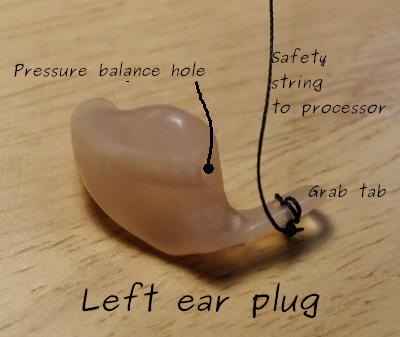 New Ear Plug Design
New Ear Plug Design
I was using an old hearing aid as a safety catch ear plug on my new left processor. I asked Dr. Nicole if she could do better than that and she came up with a custom cast ear plug with a huge pressure balance hole.
I slightly modified things by drilling a hole in the grab tab and tying the thread at that point. Works very well, thanks.
(The standard shirt collar clip and string design totally sucked.)
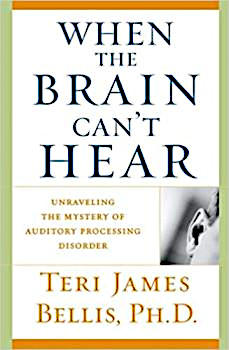 At first, I thought that "auditory therapy" would get me nowhere, but now I think it's a very big deal. It's not a hard and fast "treatment", but it makes you aware of why you still don't understand everything when you can hear everything. It's because your brain doesn't get it yet - it has a hard time processing all the sounds going into it. This takes a long time to re-activate your brain - months or even years. And also your brain does not trust what it hears, so it doubts the words that the hearing implants are sending to it. This sounds like BS, but I can tell you that it's a big issue with me. I'm sure my word identification problems are mostly that my brain is stumbling, not because the implants aren't working.
At first, I thought that "auditory therapy" would get me nowhere, but now I think it's a very big deal. It's not a hard and fast "treatment", but it makes you aware of why you still don't understand everything when you can hear everything. It's because your brain doesn't get it yet - it has a hard time processing all the sounds going into it. This takes a long time to re-activate your brain - months or even years. And also your brain does not trust what it hears, so it doubts the words that the hearing implants are sending to it. This sounds like BS, but I can tell you that it's a big issue with me. I'm sure my word identification problems are mostly that my brain is stumbling, not because the implants aren't working.
So .... I am working with a therapist to understand this stuff and do word / listening exercises to get better at "word identification" at normal conversation speed.
Also learning what to do when I miss a word. My usual practice is to say "WHAT?" and people hate that, so I'm trying other things to say, like "Did you say _______?".
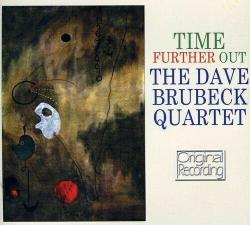 Back a few months, Keely M., my auditory therapist encouraged me to explore listening to music and working hard to re-calibrate my brain to what it's hearing. I got some decent hi-fi speakers, reorganized my Jazz CD collection, bought some new ones, and have been working on this diligently - just sitting down and listening to music with no distractions.
Back a few months, Keely M., my auditory therapist encouraged me to explore listening to music and working hard to re-calibrate my brain to what it's hearing. I got some decent hi-fi speakers, reorganized my Jazz CD collection, bought some new ones, and have been working on this diligently - just sitting down and listening to music with no distractions.
I am extremely happy with (I'll call it) the new experience of music. I am listening to one CD almost every night, and just letting the music flow into my head without complaining about how different it used to sound. Giving my brain a chance to relearn listening.
In addition to using the accessory mini-mic (described somewhere above), I am now using the cell phone bluetooth gizmo. This gadget requires that your PC, cell phone or CD player have Bluetooth built into it. It's a trick to get your implant processors and your cell phone and tablet computer connected, but trying the instructions a few times, I got it done.
This setup is very nice because there are no wires or connectors involved as with the mini-mic setup. Works pretty well so far - I can watch any videos on my tablet now with sound !!
For electronic devices that do not have Bluetooth built in, the Cochlear© brand "TV streamer" will stream (via Bluetooth) from any device that you can connect to it by wire. (It streams only to Cochlear brand sound processors). It's a bit twitchy getting the connection, but it works great, and not just for TVs.
I really wish I had 2 of these for the house.
Dr. Nicole's torture chamber. Beeps, words without noise, sentences without noise, then words and sentences with noise. With each implant alone and then with both implants. Like drilling teeth without novacaine.
Well, my scores have improved significantly in 3 months and super-significantly since before the implant.
I also learned that your left and right auditory nerves may not be exactly alike, in terms of carrying signals to the brain. I had been thinking they are like identical wires carrying the same electric signal, but that's not correct. That's why each implant processor is calibrated differently, based on the torture chamber test results.
Keely, I will miss meeting with you very much. I learned so much about the process of hearing, listening, understanding what I hear. It's been a valuable and very pleasant education, and I thank you enormously.
I was skeptical, you know, but glad to say I was wrong. My "therapy" has been extremely helpful. More than anything, after years of being away from music, I am back to listening to my (large and growing) collection of classic Jazz. This alone has changed my life.
Anyway, I will miss you, our discussions and your guidance.
Be safe out there.
Dave